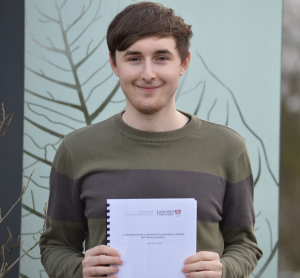Internship: researching links between extreme weather events and climate change
Julian Shield joined us for a five week internship as part of his MSci in Environmental Science at Lancaster University. Since we installed our weather station in September 2019, we have already observed very high temperatures of 32.7 °C (on 25 July 2019) and heavy rainfall of 34 mm (on 29 September, the day that one of the world cycling championship races, which passed close by, almost looked like turning into a swimming event). To put our observations into some context, the July heatwave temperature measurements were similar to the Met Office official data and were about 12°C hotter than the long term average; rainfall on 29 September was 22.4 mm at an Environment Agency rain gauge about 5.5 km away from ours (which we expect will be more uncertain – we have not yet been able to test its accuracy).
Can extreme weather events like the ones we have measured tell us anything about climate change? Scientific analysis called extreme event attribution tries to answer that question. For example, the heat wave in July 2019 in the UK and elsewhere in Western Europe has been analysed and found to have been made more likely because of climate change caused by human actions.
We have previously contributed to research on the influence of climate change on recent flooding in the UK, but we are also interested in what the scientific literature says about this for other notable weather events around the world. Over the summer of 2019, Julian Shield, an environmental sciences MSc student, worked with us on a placement to look into this question.
Julian’s blog follows below:
 “I’m Julian, and I am in my final year studying for an MSci in Environmental Science at Lancaster University. In summer 2019 I had a 5-week internship with JBA Trust, studying the relatively new field in climate science of Extreme Event Attribution (EEA). There are two main approaches in this field: risk-based (whether climate change made the event more likely than would otherwise have been the case), and storyline (investigating the influence of climate change on the thermodynamic processes that lead to events). Studies of EEA often try to quantify the influence of climate change on an event, for example by calculating the increase or decrease in likelihood of an event in today’s climate compared to that of pre-industrial times. This is done by modelling the world as it is (complete with the climate change already caused by greenhouse gas emissions), and then the world as it would have been without the emissions. The EEA then involves looking at how the probability of occurrence of the event differs between the two. This allows the question “was this weather event influenced by climate change?” to be answered.
“I’m Julian, and I am in my final year studying for an MSci in Environmental Science at Lancaster University. In summer 2019 I had a 5-week internship with JBA Trust, studying the relatively new field in climate science of Extreme Event Attribution (EEA). There are two main approaches in this field: risk-based (whether climate change made the event more likely than would otherwise have been the case), and storyline (investigating the influence of climate change on the thermodynamic processes that lead to events). Studies of EEA often try to quantify the influence of climate change on an event, for example by calculating the increase or decrease in likelihood of an event in today’s climate compared to that of pre-industrial times. This is done by modelling the world as it is (complete with the climate change already caused by greenhouse gas emissions), and then the world as it would have been without the emissions. The EEA then involves looking at how the probability of occurrence of the event differs between the two. This allows the question “was this weather event influenced by climate change?” to be answered.
I looked at 167 studies published in the BAMS (Bulletin of the American Meteorological Society) special issues on extreme events and World Weather Attribution web site. These articles have studied events around the world ranging from heatwaves, to extreme precipitation, to drought.
From my analysis of the BAMS articles, I found that 40 of the 41 heatwaves investigated between 2011 and 2017 were attributable to climate change. Other event types are much more variable in their attribution: for example, for extreme rainfall, snow or flooding events, about half (15 out of 29) were found to be attributable, at least in part, to climate change.”

